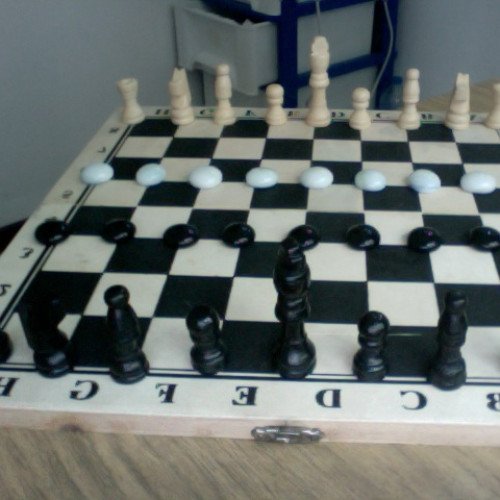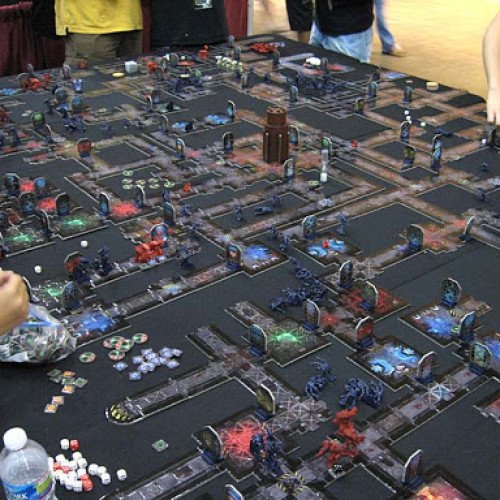OUK-KHMER VS SPACE HULK

OUK-KHMER
Ouk-Khmer (also known as Cambodian Chess) is a chess variant which D. B. Pritchard claimed was played in Cambodia although its actual origins appear to be unknown. Pritchard gives the source as P. A. Hill. It combines elements of makruk and xiangqi. Similar to xiangqi, it is played on the intersections of an 8×8 monotone board (instead of 8×9). Contrary to Pritchard's claim, the actual variety of chess played in Cambodia today, known as "Ok" or "Ouk Chatrang", is nearly identical to makruk. The authenticity of the game described by Pritchard remains doubtful. Pritchard (The Encyclopedia of Chess Variants, 1994) described this game as "an old variant displaying elements of Burmese Chess, Chaturanga and Makruk". However, the rules provided appear to be a hybrid of Makruk and Xiangqi. For example, play on the intersections and the movement of the fish (pawn) follow Xiangqi rules. The advanced placement of the full line of pawns resembles the initial setup of makruk. The naming of the "boat" also follows makruk. John Gollon, the author of "Chess Variations: Ancient, Regional, and Modern", received a description of a chess game in 1969 from a U.S. serviceman who claimed to have obtained the details from a Cambodian born guerrilla officer he was questioning. The serviceman expressed concern that he may have been mistaken about some of the details and Gollon stated that he was never able to confirm the details with an official Cambodian source. He admitted in his letter: “The correspondent later expressed some concern that he may have been mistaken in some details.” In 2007, the English chess specialist John Beasley published a revised edition of late D.B.Pritchard's book (The Classified Encyclopedia of Chess Variants), in which more details from Gollon's letter were given (such as the local names of the chessmen, not included in the 1st edition) and where Beasley expressed his strong doubt about the authenticity of this kind of chess. In reaction to this publication, Beasley was sent information that a set of this chess had made an apparition in an exhibition in Tokyo in 2002 as well as in several Japanese books that preceded or followed, written by Umebayashi Isao and Okano Shin. They could have rediscovered these rules by translating a book bought in Cambodia, where the Elephant could not capture sideways. The names they gave for the chessmen were somewhat different from Gollon (Kwon, Neamahn, Kwo, Seh, Tuuk, Trey as for the table). Umebayashi and Okano designated that game as "shattrong". A photo of a complete set was available showing the 18 pieces on a board with marked diagonals. Beasley published a corrective note in the British specialized magazine Variant Chess (Issue 55, September 2007 and issue 64, August 2010 ) to acknowledge this second “evidence”. He acknowledged that the game is apparently absent "from the streets of Phnom Penh in 2003" and stated that Peter suggested "that this may have been a minor consequence of the mass killings of the Pol Pot era.". The situation has been cleared out in 2012 with the help of a Japanese chess researcher, Yasuji Shimuzu who got in touch with Umebayashi Isao. First, it has been now understood that Umebayashi and Okano's books were simply presenting a reconstruction of the “Cambodian” chess which they had discovered in Pritchard's first edition. As Pritchard didn't name the chessmen in his first edition, the Japanese authors extrapolated the names with the help of a dictionary. No Cambodian books had been consulted and even found. The difference in Elephant's move was simply a misreading. Finally, looking for an illustration, they just set up a set of makruk with additional Fishes and Officials over a facsimile Burmese board that they had and fitted well the size of his chessmen. John Beasley published a corrective note on his website http://www.jsbeasley.co.uk/. His conclusion is that the game described to P. A. Hill in 1969 appeared once more to reduce to a single informant whose statements were at variance with all other known testimony. Moreover, John Beasley has found and proven that the game is flawed if played seriously.
Statistics for this Xoptio

SPACE HULK
Space Hulk is a board game for two players by Games Workshop. It was released in 1989. The game is set in the fictional universe of Warhammer 40,000. In the game, a "space hulk" is a mass of ancient, derelict space ships, asteroids, and other assorted space debris. One player takes the role of Space Marine Terminators, superhuman elite soldiers who have been sent to investigate such a space hulk. The other player takes the role of Tyranid Genestealers, an aggressive alien species which have made their home aboard such masses. In Warhammer 40,000, the term "space hulk" is used to refer to any massive derelict space ship. Due to the shifting, immaterial nature of the Warp, an otherworldly realm through which space ships may travel between the stars far quicker than they would be able to through real space, some space hulks are jumbled and twisted agglomerations of multiple vessels lost to the Warp throughout centuries or millennia. Space hulks may house more than just Genestealers; other threats aboard can include human followers of the dark gods of Chaos, nightmarish Warp Daemons, and Orks who use space hulks as their "standard" method of interstellar travel. Genestealers were described in an entry of the "Aliens and monsters" section of the first edition of Warhammer 40,000 (the "WH40K - Rogue Trader" manual), but they were very different from their Space Hulk incarnation, which was more influenced by the xenomorphs depicted in the Alien franchise. Since the 1990s, subsequent games like Warhammer 40,000 and Epic have absorbed them as part of the overall Tyranid army where they serve as the shock troops, although their origins are not related to any other Tyranid broods. A force composed purely of Genestealers can still be fielded as a sub-type of the Tyranid army, in what is known as a Genestealer Cult. The Cult is described in the in-game background as an infiltration force that weakens a target planet, infecting the local population and causing civil unrest in advance of the arrival of the main Tyranid hive fleet.